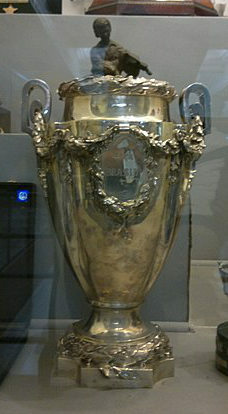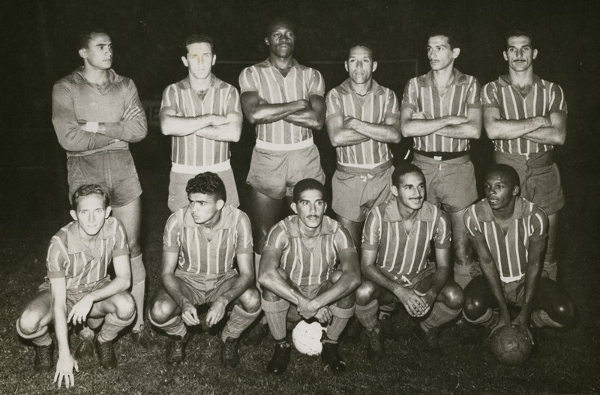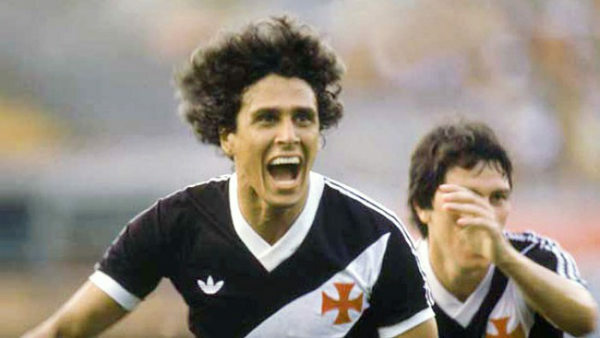O Brazilian Football Championship, popularly called brazilian, and the main national competition played between clubs. It is currently divided into four divisions: Serie A, B and C, with 20 teams each, and Serie D, with 68.
THE first edition official Brazilian Championship was held in 1971, however, in 2010, two tournaments held before the 1970s were recognized as national competitions: the Brazil Cup and the silver cup. Today, the history of the Brazilian Championship is told from the Brazil Cup.
Read too:Fun facts from football history
History
Created by the Brazilian Sports Confederation (CBD), currently CBF, in 1959, the Brazil Cup is considered the first national competition between football clubs. The creation of the tournament was intended to replace the Brazilian Championship of State Teams, which was a competition played between the best teams in the states of Brazil.
The Brazil Cup brought together the country's state champion teams and gave the champion the right to represent him in the America's Cup of Champions (
Copa Libertadores da America) which, at that time, brought together the champions of each country of the South America.At first editions of the Brazil Cup were played with knockout games, because, due to the complications of transportation and transportation at the time, it was difficult to organize a more integrated national tournament, in a country with dimensions as large as Brazil.
To learn more about football history, read: Football history | All about this national passion!

Brazil Cup
The first championship was attended by 16 teams state champions, and the champions of the state of São Paulo and the Federal District — at the time, the capital of Brazil was Rio de Janeiro — entered the final phase. Bahia's team was the first to win the title of the competition and the spot to represent Brazil in the 1960 American Champions Cup, after beating Santos in the final.

Bahia team, first Brazilian champion, in 1960.
In 1967, O Rio-São Paulo Tournament, which was an interstate competition played by teams from Rio de Janeiro and São Paulo, was expanded to the national scope and received the name of Roberto Gomes Pedrosa Tournament, the “Robertão”, in honor of the goalkeeper Pedrosa, of São Paulo and of the Brazilian National Team of the 1934 Cup, who died in 1954 as president of the São Paulo Federation. Robertão was played in parallel to the Taça Brasil.
As of the second edition, the Robertão tournament was called the Silver Cup. The competition ended up pleasing the clubs and fans, as it was the first to bring together the country's top teams with the best players. With that, the average attendance of the championship increased, as the games had a better level, and the competition began to have more credibility and intense media coverage. The consequence was that the tournament became more profitable for the participating teams, who began to take a greater interest in the competition.
Robertão's success made the CBD decide, in 1971, to transform the tournament into a National Club Championship.
See too: The beginnings of Brazilian football
Do not stop now... There's more after the advertising ;)
National Championship, Brazil Cup and Gold Cup
Between 1971 and 1973, the newly created National Club Championship was played in the same format as the Silver Cup. However, the number of teams increased from 17 to 20, and a second division was created. O Atlético-MG it was the first champion, in 1971.
During the first years of the National Club Championship, football suffered political interference gives Military dictatorship. In 1975, the president of the CBD, João Havelange, left the institution's command to take over FIFA, and Admiral Heleno Nunes took over the CBD.
Aiming to please colonels from regions where football did not have much visibility and create a feeling of national integration, Admiral Heleno raised it to more than 90 the number of teams of the national championship. With this change, the competition changed its name again and was renamed Brazil Cup.
In 1979, CBD was spun off into creation of the Brazilian Football Confederation, the CBF, which was specifically geared towards football. The following year, with the new institution, the tournament was renamed Golden Cup and, for the second time, it had two divisions. A year later, the third division was created.

Headquarters of CBF, in Rio de Janeiro.
13 Club and União Cup
At the end of the decade of 1980, Brazil suffered a economic crisis and many clubs and federations have been affected by this situation. With this, the CBF announced, in 1987, that it would not be able to maintain a national championship and suggested a return to how it was in the Taça Brasil, with regionalized games.
the 13 stronger clubs economically rejected the idea of CBF, formed an institution called 13 club and created their own championship: the Union Cup. Together with the CBF, it was defined that the Copa União would be the Brazil Cup Green Module, while the CBF would organize the Yellow Module. The proposal was that the champions and runners-up in each module would have to face each other, in the final, to define the two representatives of Brazil in the 1988 Libertadores.
Flamengo and Internacional were, respectively, champion and vice-champion of the Copa União, but if denied to dispute the quadrangular with the champion and vice of the Yellow Module, which were the Sport and the Guarani. The National Sports Council (CND) - defunct body that was responsible for regulating and regulating all sports, federations and confederations — considered Flamengo as the Brazilian champion of 1987, while the CBF considered the Sport. The dispute, then, ended up in the common court.
In 1988, a division between Clube dos 13 and CBF ended and the Copa Brasil was played with 24 teams. For the first time, the competition also had a access and lowering system to meet FIFA requirements.
Anyway, Brazilian Championship
The CBF intended to further streamline the tournament, and with that, many less expressive clubs were no longer part of the national championship. To avoid their extinction, the CBF created a secondary competition, the Copa do Brasil, which could bring together clubs from all states. Avoiding confusion between the names of the tournaments, Copa Brasil was renamed Campeonato Brasileiro, in 1989.
In 1999, the tournament adopted a new format for demotion, determining that the four clubs with the lowest point average would fall to Serie B in the 1998 and 1999 championships. The system only lasted one season. In the first phase of the competition, it was discovered that a player from São Paulo was illegally registered, and the CBF decided to punish the club by canceling the games in which he participated. With that, Internacional and Botafogo gained points that led Gama to relegation. The team then decided to sue the CBF, which could not organize the tournament in 2000.
Once again, Clube dos 13 organized the championship again, which, that year, was called Copa João Havelange and had the participation of Fluminense and Bahia as guests, since both were in the Serie B. The championship was divided into four modules (blue, yellow, green and white), with the participation of 116 teams. The final was between Vasco, from Modulo Azul, and São Caetano, from Modulo Amarelo, and the team from Rio de Janeiro he was the champion in a tumultuous final, marked by the collapse of the fencing at the São Januário stadium.
Know more: July 19 — National Football Day
Running points and end of the knockout
Over 40 years being held, the Brazilian Championship there was no stability in the rules and not one standard dispute system, being performed in a different format almost every year. In 2003, the story changed. The tournament adopted the running stitch format, which is carried out to the present day. In this game mode, everyone plays against everyone in turn and return. Cruzeiro was the first champion of this format, among the 24 teams participating in Serie A.
With an established format in the tournament, another type of controversy arose in 2005. O referee Edilson Pereira de Carvalho was stuck after being accused of manipulate the results of the games to guarantee the entrepreneurs profit who invested in game sites. The scandal became known as Whistle Mafia and caused the Superior Court of Sports Justice (STJD) to annul 11 games refereed by the referee.
The number of 20 participants was defined in the 2006 tournament, with the best four teams qualifying for the Copa Libertadores, and the worst four being relegated to Serie B.
Read too: How does the soccer ball curve?
Names of the Brazilian Championship:
1959 to 1968: Brazil Cup
1967 to 1970: Roberto Gomes Pedrosa Tournament (Robertão) or Silver Cup
1971 to 1974: National Club Championship
1975 to 1979: Brazil Cup
1980: Gold Cup and Brazil Cup
1987 and 1988: Union Cup
1989 to 1999: Brazilian championship
2000: João Havelange Cup
2001 and 2002: Brazilian championship
2003 to date: Brazilian Championship - Serie A
Cup of Polka Dots
In 1975, the Federal Savings Bank created the Brazil Cup trophy to be delivered to the Brazilian champions. The idea was that the champion team would receive the trophy and then return it to the bench, but the first club to win the championship three times in a row or five times in total, from 1975 onwards, could keep the trophy in definitive. Due to your Format, the trophy was dubbed the Bolinhas Cup.
Brazilian champion of 1992, Flamengo considered that it had won its fifth title (1980, 1982, 1983, 1987, 1992). However, as the 1987 title was in court, the CBF interrupted the delivery of the Bolinhas Cup and the matter was “forgotten” for 15 years.
In 2007, São Paulo was the Brazilian champion for the fifth time and requested the Cup of Bolinhas. In addition, the following year, the São Paulo club was champion for the third consecutive time. In 2011, the trophy was finally handed over to São Paulo, but had to be returned to Caixa the following year, by court order. Justice had not yet determined the true champion of 1987.

Bolinhas Cup is in a safe at Caixa Econômica Federal.
After 30 years, in 2018, the Federal Supreme Court (STF) ultimately decided that Sport was the only Brazilian champion in 1987. The decision guarantees São Paulo the right to keep the Cup of Bolinhas, but, so far, it has not been delivered by Caixa.
See too: Six important facts in the history of the Olympics
Unification
In 2010, CBF decided unify the Brazilian Championship, that is, the institution recognized competitions prior to 1971, giving the Brazil Cup and the Robertão Tournament the equivalent weight of the Brazilian Championship.
The recognition of the championships was a request from some Brazilian clubs, who met with the then president of the CBF, Ricardo Teixeira. See the clubs arguments:
The decision to unify the titles was based on a thorough research performed by journalist and researcher Odir Cunha. He carried out the study, to seek recognition of the Taça Brasil title and the Roberto Gomes Pedrosa Tournament as national championships, and produced a dossier, which influenced CBF's decision.
The material was later turned into a book. O Dossier: unification of Brazilian titles from 1959 it is available in several bookstores and on the internet.
Brazilian champions per year

Palmeiras is the greatest champion of Brazil.
With the unification of the Brazilian Championship, in 2010, the palm trees is considered the greatest champion of the competition, with 10 titles. Second is the saints, with eight titles, and, thirdly, the Corinthians it's the Flamengo, with seven. See the amount of titles for each club:
Palmeiras (10), Santos (8), Corinthians (7), Flamengo (7*), São Paulo (6), Cruzeiro (4), Fluminense (4), Vasco (4), Internacional (3), Bahia (2), Botafogo (2), Grêmio (2), Atlético-MG (1), Atlético-PR (1), Coritiba (1), Guarani (1) and Sport (1*).
See the champions by year:
Year |
Brazil Cup |
Robertão |
Brazilian championship* |
1959 |
Bahia |
||
1960 |
palm trees |
||
1961 |
saints |
||
1962 |
saints |
||
1963 |
saints |
||
1964 |
saints |
||
1965 |
saints |
||
1966 |
cruise |
||
1967 |
palm trees |
palm trees |
|
1968 |
Botafogo |
saints |
|
1969 |
palm trees |
||
1970 |
Fluminense |
||
1971 |
Atlético-MG |
||
1972 |
palm trees |
||
1973 |
palm trees |
||
1974 |
Vasco |
||
1975 |
International |
||
1976 |
International |
||
1977 |
Sao Paulo |
||
1978 |
Guarani |
||
1979 |
International |
||
1980 |
Flamengo |
||
1981 |
Guild |
||
1982 |
Flamengo |
||
1983 |
Flamengo |
||
1984 |
Fluminense |
||
1985 |
Coritiba |
||
1986 |
Sao Paulo |
||
1987 |
Sport/Flemish¹ |
||
1988 |
Bahia² |
||
1989 |
Vasco |
||
1990 |
Corinthians |
||
1991 |
Sao Paulo |
||
1992 |
Flamengo |
||
1993 |
palm trees |
||
1994 |
palm trees |
||
1995 |
Botafogo |
||
1996 |
Guild |
||
1997 |
Vasco |
||
1998 |
Corinthians |
||
1999 |
Corinthians |
||
2000 |
Vasco³ |
||
2001 |
Atlético-PR |
||
2002 |
saints |
||
2003 |
cruise |
||
2004 |
saints |
||
2005 |
Corinthians |
||
2006 |
Sao Paulo |
||
2007 |
Sao Paulo |
||
2008 |
Sao Paulo |
||
2009 |
Flamengo |
||
2010 |
Fluminense |
||
2011 |
Corinthians |
||
2012 |
Fluminense |
||
2013 |
cruise |
||
2014 |
cruise |
||
2015 |
Corinthians |
||
2016 |
palm trees |
||
2017 |
Corinthians |
||
2018 |
palm trees |
||
| 2019 | Flamengo |
¹Brazil Cup/Union Cup
²Brazil Cup
³João Havelange Cup
Know more: Brazilian athletes who won gold in the Olympics
Format
Currently, the Brazilian Championship is played in several categories: Male (Series A, Series B, Series C and Series D), Feminine (Female, Female A1 and Female A2) and Base Categories (Aspirants, U-20 and U-17).

Brazilian Championship brings together 20 teams in Serie A.
O main tournament of football in the country is the Brazilian Series A Championship. It is played from April to December and has 20 teams, who play against each other in two turns, totaling 38 rounds. The format is the running stitches, that is, the team that has added the most points at the end of the competition wins the title of Brazilian champion of the year.
At four teams with the best placement earn the right to participate in the Copa Libertadores da America. The fifth and sixth places participate in Pre-Libertadores. The other teams that occupy up to 12th place win places in the Copa Sudamericana. The last four placed are relegated to Serie B.
top scorers
Since the championship was created in 1959, many players have stood out as scorers, but the one who scored the most goals in the tournament was Roberto Dynamite, with 190 goals. then comes Romario, with 154, and, with one goal less, Edmundo is the third.

Roberto Dinamite is the greatest scorer in the history of the Brazilian Championship.
In the era of straight points, other players also stood out in the number of goals. At this stage, the top scorers are the attacker Fred (still in activity and with more than 140 goals), followed by midfielder/back Paulo Baier (106 goals).

Fred is the league's top scorer in the points-running era and is still in business.
In a single edition of Brasileirão, after defining the running points, the main scorers are Washington (34 goals, in 2004, by Atlético-PR), Dimba (31 goals, in 2003, by Goiás), Gabriel Barbosa (25 goals, in 2019, by Flamengo), Jonas (23 goals, in 2010, by Grêmio) and Borges (23 goals, in 2011, by Santos).
never been demoted
Teams that have never been demoted.
Of the 20 teams that make up the main division of the Brazilian Championship, only three were never demoted: Flamengo, saints and Sao Paulo. The teams have been playing for the first division since it was created.
Most relegated clubs
The teams that suffered the most relegation in the Brazilian Championship are America-MG and Victory, both have already fallen six times. Next are Coritiba, Goiás, Holy Cross and sport, with five falls.
By Giullya Franco
Journalist


